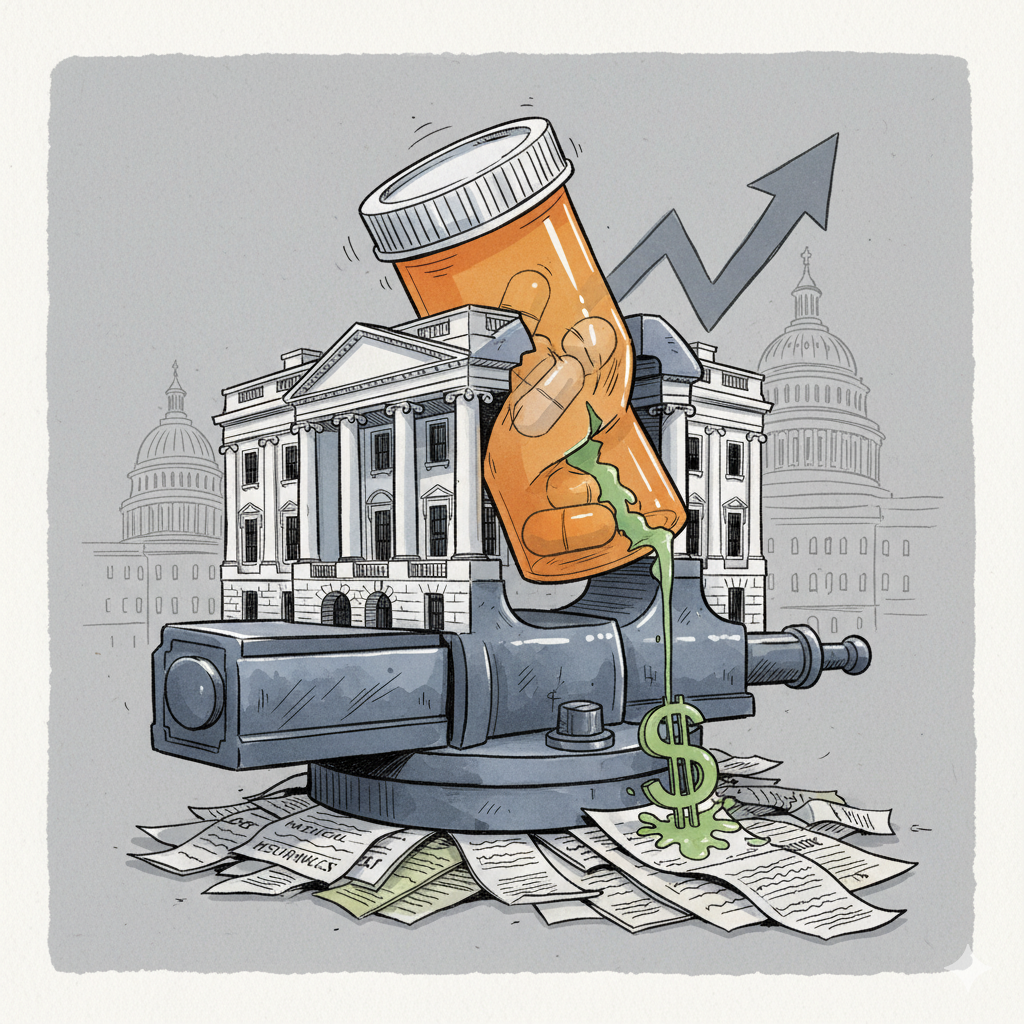The Trump-AstraZeneca Tariff Showdown and the Birth of Direct-to-Consumer Discounts

The Trump-AstraZeneca Tariff Showdown and the Birth of Direct-to-Consumer Discounts


1. Executive Summary: A Strategic Compact of Political Imperative and Commercial Pragmatism
On October 10, 2025, the Trump administration and AstraZeneca PLC announced a landmark agreement.¹ The deal aims to lower prescription drug prices for American consumers.²
This is the second agreement of its kind, following a similar pact with Pfizer Inc. in September 2025.³ It is a direct result of the administration’s aggressive “Most Favored Nation” (MFN) policy. This policy seeks to align U.S. drug prices with the lowest prices that other developed nations pay.⁴
The agreement is not a simple price reduction. It is a complex strategic maneuver, born from a convergence of political needs and commercial pragmatism.
For the Trump administration, the deal represents a tangible, high-profile victory in its war on high drug prices—a key issue for the American electorate.² For AstraZeneca, it is a calculated measure to mitigate significant risk. The company faced a credible threat from the administration of tariffs up to 100% on imported pharmaceuticals.⁵
The deal’s structure is dual-pronged. Each prong is designed to achieve distinct political and policy objectives.
The central thesis of this analysis is that the agreement’s direct impact on drug affordability for most Americans will be minimal. This includes those covered by commercial insurance or Medicare. While the deal is a significant political achievement for the Trump administration and a shrewd strategy for AstraZeneca, its tangible benefits are limited.
Multiple independent healthcare economists and policy experts support this conclusion. They note that the deal’s primary financial impact is contained within the Medicaid program. This program already benefits from substantial statutory discounts.⁸
Therefore, the deal’s true significance is not a fundamental reordering of U.S. drug pricing. Instead, it establishes a powerful new coercive framework. In this framework, the administration weaponizes trade policy to achieve healthcare policy objectives. This sets a potent precedent for all future government-industry negotiations.

After an 𝕏 history filled with plenty of bogus ideas, my stances have obviously evolved, so consider the following my most current platform.
Don’t reform the failed systems of the past or indulge the inaction of extreme libertarianism.
Signature National Initiatives
Taxation, Revenue & An American Dividend
Economic & Financial Policy
The Black Hole of Healthcare Spending
There are staggering statistics about the current US national debt and the percentage attributed to healthcare programs like Medicare and Medicaid.
There are well-documented problems of fraud, waste, and abuse: upcoding, phantom billing, medically unnecessary procedures …
Traditional human-led audits are slow, expensive, and only catch a tiny fraction of the problem, creating a massive accountability gap.
Enter the AI Auditor, A New Paradigm for Transparency
Using advanced AI and machine learning models to analyze massive healthcare claims datasets in real-time.
AI can identify complex patterns of fraud that are invisible to human auditors: collusive networks of providers, subtle anomalies across millions of claims …
The current model is “pay and chase” … what about a future of “pre-payment verification” where AI flags suspicious claims before a single taxpayer dollar is spent?
(more…)
The analogy comparing the national debt to the COVID-19 “flatten the curve” mantra is a profoundly misleading and dangerous simplification of the crisis we face. The comparison is particularly flawed when one recalls the data inconsistencies during the initial wave of COVID-19. In early 2020, many observers noted with suspicion that official data from sources like Johns Hopkins University showed a startlingly low number of recoveries in the United States. This data “weirdness,” born from the chaos of tracking a novel virus in real-time, highlights a key difference: the COVID-19 curve was a matter of incomplete, real-time data, while the national debt curve is a matter of precise, cumulative accounting.
The national debt isn’t a virus that will simply “burn out” or be defeated by a short-term, emergency response. It is a chronic, metastasizing cancer on the body politic, the result of decades of policy decisions. Proposals for a “debt ceiling app” or other simple fixes are shortsighted political theater. Congress has repeatedly demonstrated its willingness to raise the debt ceiling, rendering it more of a talking point than a genuine constraint.
The real technological revolution that offers a path forward is not in financial gimmicks, but in artificial intelligence, LLMs, and robotics. Their promise is not magical “growth,” but something far more valuable: the ruthless elimination of waste, fraud, and abuse. The potential for automation to overhaul the medical and insurance industries—the true drivers of our debt—is immense. Imagine humanoid robots, like Tesla’s Optimus, providing comprehensive elder care. These machines could handle everything from showering a grandparent to monitoring their vitals, ending the soul-crushing and financially ruinous nursing home industry. This isn’t science fiction; it is a necessary step to slash the costs that are bankrupting our nation.
(more…)
Our nation is on life support. A $37 trillion national debt is not a number; it is a mortal wound. At the heart of this fiscal cancer lies a bloated, failed healthcare system that acts as a conveyor belt to national bankruptcy. Tinkering is over.
This is The Phoenix Mandate, a declaration of war on the debt that threatens to extinguish America. It is a national survival plan built on five pillars of strength, innovation, and absolute, non-negotiable accountability.
We will end the religion of constant, wasteful care by fostering a culture of health independence. A key part of this is embracing the Personal Health Revolution, led by devices like the Apple Watch, which put the power of a lab on your wrist.
However, we recognize that the supply chain for these critical devices represents a dangerous vulnerability to our adversary, China. This is unacceptable.
The American Sovereignty Rider: If any adversary threatens our access to the critical components for these devices, the President will immediately invoke the Defense Production Act. A national mandate will be issued to a new coalition of loyal American companies, led by the chip-making power of Intel and the advanced manufacturing of Corning. They will be directed to produce a “Sovereign Device”—a secure, American-made digital lifeline to guarantee every citizen access to essential health monitoring. We will not allow our national health to be held hostage.
The modern nursing home is a moral and financial catastrophe. We will dismantle this cruel and inefficient model. The second pillar of the Phoenix Mandate is to empower our elders to age with dignity in their own homes through a technology-driven revolution in elder care, deploying telepresence robots, smart home safety nets, and an on-demand system of human care that provides better results at a fraction of the cost.
(more…)The comprehensive legislation, dubbed by some the “Big Beautiful Bill” (BBB), includes a substantial set of provisions pertaining to healthcare. These proposals aim to reform Medicaid, Medicare, the Affordable Care Act (ACA), and other health-related sectors. However, rather than offering genuine solutions, these healthcare sections largely entrench and expand failed federal programs. Market-based and state-level solutions are the appropriate path forward; continuing with the current trajectory will only worsen our $37 trillion national debt and further degrade our healthcare system.
Medicaid and CHIP: Entrenching a Failed System
A significant portion of the bill addresses Medicaid and the Children’s Health Insurance Program (CHIP), programs that have demonstrably failed to deliver efficient, fiscally responsible healthcare.